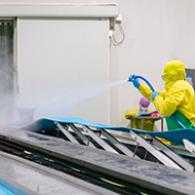Newly manufactured stainless steel equipment is cleaned of any oils and greases used in the fabrication process. Then an acid (typically nitric) is used to remove free iron from the surface. Slowly and naturally, a passive layer develops on the surface of the steel as the chromium at the surface reacts with oxygen in the air to produce chromium oxide. The term “passive” refers to the steel now being unreactive, which is hugely beneficial for equipment used in food, beverage, dairy, pharmaceutical, and cosmetics processing.
4Cr + 3O2 → 2Cr203
This unreactive layer is invisible and only a few molecules thick, but it provides a barrier that prevents oxygen and moisture from reaching the iron underneath. If oxygen came into contact with iron, the iron would oxidize, or rust, producing an unwanted yellow to orange or red color, weakening the steel, which could cause it to flake which creates a contamination risk and safety issue.
The Impact of Surface Damage on Stainless Steel Processing Materials
After stainless steel equipment has been installed and is in operation, the passive layer can be damaged or removed by physical abrasion (welding, brushing, grinding, scraping) or chemical reactions. The passive layer can also be weakened by physical damage due to expansion and contraction caused by heating and cooling. If this damage happens faster than the passive layer can heal itself naturally, rusting will result.

The natural regeneration process can be impeded by the products being processed or the cleaning chemicals that are in regular contact with the surface. Companies in the food and beverage processing industry and life sciences industry are acutely aware that the insides of pipes and vessels are vulnerable to being damaged because of the stresses that they come into contact with, sometimes for 24 hours a day. A more effective passive layer can be produced by chemical methods.
What is Chemical Passivation?
Chemical passivation treats stainless steel equipment to regenerate the protective passive oxide layer. It is a three-step process:
The first step is to clean the surface of all organic greases and mineral or silicone oils. Speciality cleaners need to be used to dissolve these impurities. Standard alkaline products used to remove organic oils and greases are normally not suitable to remove mineral and silicone oils and greases.
It is important to note that the stainless steel surface to be passivated needs to be thoroughly degreased. It is essential. If grease remains on the surface of the metal, the passivating acid will not be able to reach the metal surface underneath the grease and these parts will not be passivated.
The degreasing step should be validated, typically by a camphor test. This test is very sensitive to oil and grease residues. If residues are still present, the degreasing step needs to be repeated.
The second step is to remove any free iron or iron compound from the surface of the equipment. It is vital to remove iron impurities before chromium oxidation; otherwise, the iron will create a localized site where corrosion can continue. Acid is used to dissolve iron and its compounds without affecting the integrity of the surface.
Finally, an oxidizer is used to force the conversion of chromium metal on the surface to the oxide form to create a protective passive layer on the surface.
Primary Passivation Method - Nitric Acid
The most commonly used chemical method to passivate a stainless steel surface is to apply nitric acid. Nitric is a strong mineral acid and will quickly dissolve all iron compounds and other trace metals on the surface. It is also a strong oxidizer and will simultaneously activate the chromium oxide layer. Even though nitric acid is a strong chemical, high temperatures and extended times are used to ensure the reaction is effective and complete.
The application condition ranges are:
Time: 3 - 4 hours
Temperature: up to 80°C/175°F
Concentration: 20% to 50% by volume nitric acid
Notes
- Under these conditions, nitric acid is very aggressive on gaskets. It may be necessary to replace gaskets after a passivation procedure.
- If the surface has signs of corrosion (eg. because of contact with seawater) stronger passivation agents based on hydrofluoric acid may be required.

Alternative Passivation Method - Citric Acid
Citric acid is sometimes used for passivating stainless steel. As well as being effective at removing iron and its compounds from surfaces, it is safer to use than nitric acid, is biodegradable, produces fewer effluent concerns and is also used as a food ingredient. But, it is not an oxidizer and will not achieve the second step of classic passivation and relies on natural air oxidation.
The application condition ranges are:
Time: 5 hours
Temperature: ambient to moderate heating
Concentration: 12% by weight
Note:
- Dichromate is a powerful oxidizer that is sometimes added to improve the oxidation of chromium. Dichromate is toxic and is not permitted in industrial effluent, so most companies avoid using it.
When to passivate
There is no simple rule to know when a piece of equipment must be passivated. Surfaces should always be passivated before being used for the first time or following any modification or repair to the equipment. The ongoing need will vary according to how the equipment is being used and whether the surface has been damaged. Some companies will choose to passivate processing equipment once per year as a scheduled maintenance procedure. Other companies need to do it more frequently because they are processing acidic foods that contain high chloride levels and are aggressive on stainless steel (salsa, tomato juice, etc.).
Processing plants that use water with a naturally high chloride level may have to passivate more frequently since the chloride will disrupt the protective layer. Pharmaceutical companies that use ultra-pure water for injection are known to passivate 4 times per year because the high purity water is hard on the surface layer!
Companies will often passivate when they notice iron deposits forming on the stainless steel and the source of iron is not the water. Test kits are available from chemical supply firms that will test for free surface iron. If a high level is found, it could be time to passivate.
Get Help and Support with your Passivation Projects
If you would like assistance on passivation protocol and chemistry from a Diversey Sector Specialist, please contact us with further information about the objects to be treated and someone will be in touch.









